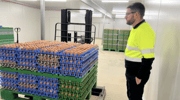The BIG change that Kmart will carry out in preparation for its new tech rollout
- Replies 10
When the announcement about Kmart’s latest team member was released, millions of jaws dropped. But it seems that the new employee, which is a robot named TORY, is only the beginning of a drastic shift in the budget retailer’s stores.
Kmart has revealed plans to change its in-store shelves to wood from metal and use foam underlays to improve the readability of radiofrequency identification (RFID) tags attached to clothing items.
To have a more accurate count of in-store inventory, the retailer is gradually tagging all of its apparel to be scanned by TORY.
RFID Rollout Manager Adam Gradon detailed that the retailer would have 100 per cent of apparel tagged at the vendor level–that is, at the overseas manufacturer–and autonomous robots reading data from the tags in stores across the country by Christmas.

The retailer had to change its fixtures for TORY. Source: Robot Report
However, he admitted that Kmart was left with no choice but to change its in-store fixtures to ensure that the tags are readable by the robot.
RFID tags and metal aren’t a great combination. The shiny surface of the metal can reflect light and jeopardise attempts to read the tag. The material can also create interference for the tag antenna.
‘A lot of our apparel sits on metal shelving, so our solution for that has been to replace the metal shelving with wooden shelving.’ Mr Gradon explained.
‘In the back-of-the-house, we also have metal fixtures. It’s funny how much metal you find in the back-of-the-house when rolling out RFID. You’d start to wish they were something else.’
‘We’ve had to apply some remediation methods there too. What we do is we place foam mats under our metal shelving which gives us a barrier to the metal.’
‘These are probably among the most challenging parts of the process but they are also rewarding. Once we overcome these challenges in simple ways, we’re bound to have a really great outcome.’ he continued.
The RFID tagging effort was first introduced in Seattle at Kmart Australia’s Anko-branded store. Since then, the concept has been applied to several Kmart stores in Australia, with some tweaks as the Anko stores have a lower volume of stock to deal with.

The majority of Kmart’s fixtures are metal. Source: Business Insider
One of the keys to success is having all of Kmart’s vendors, including those outside Australia, attach the RFID tags at the point of manufacture.
Checkpoint Systems, a business involved in the project since the early beginnings of Anko, has used its global reach to work closely with in-country vendors on simple processes to attach the tags to items.
Certain items, such as cutlery sets, required specific training on tag attachment since the products themselves could cause interference, in addition to the shop fixtures they were sitting on.
Mr Gradon added that the implementation of RFID technology had ‘provided a foundation for a multi-year transformation of the in-store customer experience’ at Kmart, which would then deliver ‘operational efficiencies and even greater value to customers’.
What are your thoughts on these new features at Kmart? Are you in favour of TORY? Looking forward to seeing wooden shelves instead of metal? Let us know in the comments below!
Kmart has revealed plans to change its in-store shelves to wood from metal and use foam underlays to improve the readability of radiofrequency identification (RFID) tags attached to clothing items.
To have a more accurate count of in-store inventory, the retailer is gradually tagging all of its apparel to be scanned by TORY.
RFID Rollout Manager Adam Gradon detailed that the retailer would have 100 per cent of apparel tagged at the vendor level–that is, at the overseas manufacturer–and autonomous robots reading data from the tags in stores across the country by Christmas.
The retailer had to change its fixtures for TORY. Source: Robot Report
However, he admitted that Kmart was left with no choice but to change its in-store fixtures to ensure that the tags are readable by the robot.
RFID tags and metal aren’t a great combination. The shiny surface of the metal can reflect light and jeopardise attempts to read the tag. The material can also create interference for the tag antenna.
‘A lot of our apparel sits on metal shelving, so our solution for that has been to replace the metal shelving with wooden shelving.’ Mr Gradon explained.
‘In the back-of-the-house, we also have metal fixtures. It’s funny how much metal you find in the back-of-the-house when rolling out RFID. You’d start to wish they were something else.’
‘We’ve had to apply some remediation methods there too. What we do is we place foam mats under our metal shelving which gives us a barrier to the metal.’
‘These are probably among the most challenging parts of the process but they are also rewarding. Once we overcome these challenges in simple ways, we’re bound to have a really great outcome.’ he continued.
The RFID tagging effort was first introduced in Seattle at Kmart Australia’s Anko-branded store. Since then, the concept has been applied to several Kmart stores in Australia, with some tweaks as the Anko stores have a lower volume of stock to deal with.
The majority of Kmart’s fixtures are metal. Source: Business Insider
One of the keys to success is having all of Kmart’s vendors, including those outside Australia, attach the RFID tags at the point of manufacture.
Checkpoint Systems, a business involved in the project since the early beginnings of Anko, has used its global reach to work closely with in-country vendors on simple processes to attach the tags to items.
Certain items, such as cutlery sets, required specific training on tag attachment since the products themselves could cause interference, in addition to the shop fixtures they were sitting on.
Mr Gradon added that the implementation of RFID technology had ‘provided a foundation for a multi-year transformation of the in-store customer experience’ at Kmart, which would then deliver ‘operational efficiencies and even greater value to customers’.
What are your thoughts on these new features at Kmart? Are you in favour of TORY? Looking forward to seeing wooden shelves instead of metal? Let us know in the comments below!







